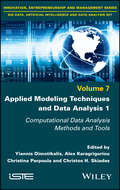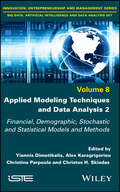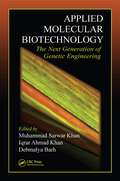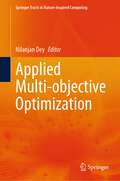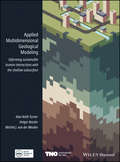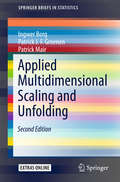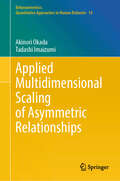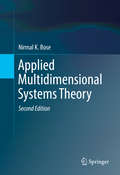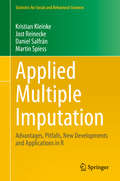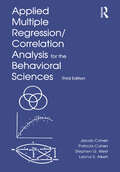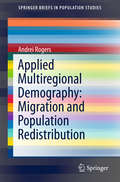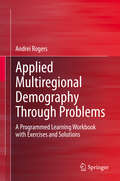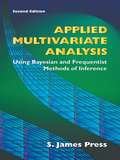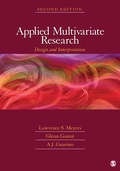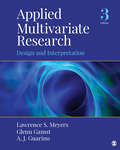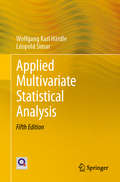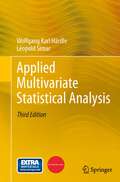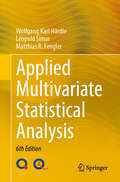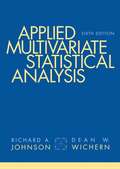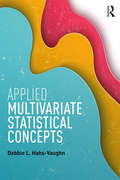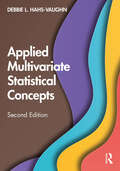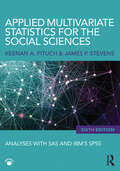- Table View
- List View
Applied Modeling Techniques and Data Analysis 1: Computational Data Analysis Methods and Tools
by Yannis Dimotikalis Alex Karagrigoriou Christina Parpoula Christos H SkiadasBIG DATA, ARTIFICIAL INTELLIGENCE AND DATA ANALYSIS SET Coordinated by Jacques Janssen Data analysis is a scientific field that continues to grow enormously, most notably over the last few decades, following rapid growth within the tech industry, as well as the wide applicability of computational techniques alongside new advances in analytic tools. Modeling enables data analysts to identify relationships, make predictions, and to understand, interpret and visualize the extracted information more strategically. This book includes the most recent advances on this topic, meeting increasing demand from wide circles of the scientific community. Applied Modeling Techniques and Data Analysis 1 is a collective work by a number of leading scientists, analysts, engineers, mathematicians and statisticians, working on the front end of data analysis and modeling applications. The chapters cover a cross section of current concerns and research interests in the above scientific areas. The collected material is divided into appropriate sections to provide the reader with both theoretical and applied information on data analysis methods, models and techniques, along with appropriate applications.
Applied Modeling Techniques and Data Analysis 2: Financial, Demographic, Stochastic and Statistical Models and Methods
by Yannis Dimotikalis Alex Karagrigoriou Christina Parpoula Christos H. SkiadasBIG DATA, ARTIFICIAL INTELLIGENCE AND DATA ANALYSIS SET Coordinated by Jacques Janssen Data analysis is a scientific field that continues to grow enormously, most notably over the last few decades, following rapid growth within the tech industry, as well as the wide applicability of computational techniques alongside new advances in analytic tools. Modeling enables data analysts to identify relationships, make predictions, and to understand, interpret and visualize the extracted information more strategically. This book includes the most recent advances on this topic, meeting increasing demand from wide circles of the scientific community. Applied Modeling Techniques and Data Analysis 2 is a collective work by a number of leading scientists, analysts, engineers, mathematicians and statisticians, working on the front end of data analysis and modeling applications. The chapters cover a cross section of current concerns and research interests in the above scientific areas. The collected material is divided into appropriate sections to provide the reader with both theoretical and applied information on data analysis methods, models and techniques, along with appropriate applications.
Applied Molecular Biotechnology: The Next Generation of Genetic Engineering
by Muhammad Sarwar Khan Iqrar Ahmad Khan Debmalya BarhApplied Molecular Biotechnology: The Next Generation of Genetic Engineering explains state-of-the-art advances in the rapidly developing area of molecular biotechnology, the technology of the new millennium. Comprised of chapters authored by leading experts in their respective fields, this authoritative reference text:Highlights the latest omics-ba
Applied Multi-objective Optimization (Springer Tracts in Nature-Inspired Computing)
by Nilanjan DeyThe book explains basic ideas behind several kinds of applied multi-objective optimization and shows how it will be applied in practical contexts in the domain of healthcare, engineering design, and manufacturing. The book discusses how meta-heuristic algorithms are successful in resolving challenging, multi-objective optimization issues in various disciplines, including engineering, economics, medical and environmental management. The topic is useful for graduates, researchers and lecturers in optimization, engineering, management science and computer science.
Applied Multidimensional Geological Modeling: Informing Sustainable Human Interactions with the Shallow Subsurface
by A. Keith TurnerOver the past decades, geological survey organizations have digitized their data handling and holdings, unlocking vast amounts of data and information for computer processing. They have undertaken 3-D modeling alongside, and in some cases instead of, conventional geological mapping and begun delivering both data and interpretations to increasingly diverse stakeholder communities. Applied Multidimensional Geological Modeling provides a citable central source that documents the current capabilities and contributions of leading geological survey organization and other practitioners in industry and academia that are producing multidimensional geological models. This book focuses on applications related to human interactions with conditions in the shallow subsurface, within 100-200 m of the surface. The 26 chapters, developed by 100 contributors associated with 37 organizations, discuss topics relevant to any geologist, scientist, engineer, urban planner, or decision maker whose practice includes assessment or planning of underground space.
Applied Multidimensional Scaling and Unfolding (SpringerBriefs In Statistics)
by Ingwer Borg Patrick J.F. Groenen Patrick MairProvides a concise, largely conceptual introduction to multidimensional scaling and unfolding.<p><p> Focuses on how to actually run and interpret MDS and unfolding in applied research (with examples from psychology, the social sciences, and market research).<p> Explains with several examples how to use the R-package smacof for MDS/unfolding and Proxscal in SPSS.<p> Includes numerous R-scripts that show how to run MDS and unfolding analyses (a file containing all scripts, and more, can be downloaded).<p>This book introduces multidimensional scaling (MDS) and unfolding as data analysis techniques for applied researchers. MDS is used for the analysis of proximity data on a set of objects, representing the data as distances between points in a geometric space (usually of two dimensions). Unfolding is a related method that maps preference data (typically evaluative ratings of different persons on a set of objects) as distances between two sets of points (representing the persons and the objects, resp.).<p> This second edition has been completely revised to reflect new developments and the coverage of unfolding has also been substantially expanded. Intended for applied researchers whose main interests are in using these methods as tools for building substantive theories, it discusses numerous applications (classical and recent), highlights practical issues (such as evaluating model fit), presents ways to enforce theoretical expectations for the scaling solutions, and addresses the typical mistakes that MDS/unfolding users tend to make. Further, it shows how MDS and unfolding can be used in practical research work, primarily by using the smacof package in the R environment but also Proxscal in SPSS. It is a valuable resource for psychologists, social scientists, and market researchers, with a basic understanding of multivariate statistics (such as multiple regression and factor analysis).
Applied Multidimensional Scaling of Asymmetric Relationships (Behaviormetrics: Quantitative Approaches to Human Behavior #19)
by Akinori Okada Tadashi ImaizumiThis is the first book that focusses the attention on applying asymmetric multidimensional scaling (MDS) and describes how to apply it in a practical manner. The book provides the know-how for prominent methods of asymmetric MDS: analysis of asymmetric relationships and the efficient use of programs of asymmetric MDS based on a distance model. These features will facilitate the work of researchers and enlighten students in disciplines such as statistics, psychology, sociology, education, marketing science, medicine, education, and other fields. Support is provided for practitioners in these areas who are, for instance, developing new products or services, investigating dominance relationships among brands or products, researching the use of antibiotics against resistance bacteria, and developing items for tests. This informative book demonstrates the analyses of data from diverse areas to show how asymmetric relationships are prevalent in real-world relationships and helps readers grasp the meanings and implications of those relationships. The results of the analyses illustrate the importance of analyzing asymmetric relationships that cannot be perceived by analysis using traditional methods, which ignore asymmetry in the data.
Applied Multidimensional Systems Theory
by Nirmal K. BoseRevised and updated, this concise new edition of the pioneering book on multidimensional signal processing is ideal for a new generation of students. Multidimensional systems or m-D systems are the necessary mathematical background for modern digital image processing with applications in biomedicine, X-ray technology and satellite communications. Serving as a firm basis for graduate engineering students and researchers seeking applications in mathematical theories, this edition eschews detailed mathematical theory not useful to students. Presentation of the theory has been revised to make it more readable for students, and introduce some new topics that are emerging as multidimensional DSP topics in the interdisciplinary fields of image processing. New topics include Groebner bases, wavelets, and filter banks.
Applied Multilevel Analysis
by Jos W. R. TwiskThis is a practical introduction to multilevel analysis suitable for all those doing research. Most books on multilevel analysis are written by statisticians; those books are difficult for non-mathematical researchers. In contrast, this volume provides an accessible account on the practical application of multilevel analysis in research. Many worked examples, with computer output, are given to illustrate and explain this subject. Datasets of the examples are available on the internet, so the reader can reanalyze the data. This approach will help bridge the conceptual and communication gap that exists between researchers and statisticians.
Applied Multiple Imputation: Advantages, Pitfalls, New Developments and Applications in R (Statistics for Social and Behavioral Sciences)
by Jost Reinecke Kristian Kleinke Daniel Salfrán Martin SpiessThis book explores missing data techniques and provides a detailed and easy-to-read introduction to multiple imputation, covering the theoretical aspects of the topic and offering hands-on help with the implementation. It discusses the pros and cons of various techniques and concepts, including multiple imputation quality diagnostics, an important topic for practitioners. It also presents current research and new, practically relevant developments in the field, and demonstrates the use of recent multiple imputation techniques designed for situations where distributional assumptions of the classical multiple imputation solutions are violated. In addition, the book features numerous practical tutorials for widely used R software packages to generate multiple imputations (norm, pan and mice). The provided R code and data sets allow readers to reproduce all the examples and enhance their understanding of the procedures. This book is intended for social and health scientists and other quantitative researchers who analyze incompletely observed data sets, as well as master’s and PhD students with a sound basic knowledge of statistics.
Applied Multiple Regression/Correlation Analysis for the Behavioral Sciences
by Jacob Cohen Patricia Cohen Stephen G. West Leona S. AikenThis classic text on multiple regression is noted for its nonmathematical, applied, and data-analytic approach. Readers profit from its verbal-conceptual exposition and frequent use of examples. The applied emphasis provides clear illustrations of the principles and provides worked examples of the types of applications that are possible. Researchers learn how to specify regression models that directly address their research questions. An overview of the fundamental ideas of multiple regression and a review of bivariate correlation and regression and other elementary statistical concepts provide a strong foundation for understanding the rest of the text. The third edition features an increased emphasis on graphics and the use of confidence intervals and effect size measures, and an accompanying website with data for most of the numerical examples along with the computer code for SPSS, SAS, and SYSTAT, at www.psypress.com/9780805822236 . Applied Multiple Regression serves as both a textbook for graduate students and as a reference tool for researchers in psychology, education, health sciences, communications, business, sociology, political science, anthropology, and economics. An introductory knowledge of statistics is required. Self-standing chapters minimize the need for researchers to refer to previous chapters.
Applied Multiple Regression/Correlation Analysis for the Behavioral Sciences Third Edition
by Jacob Cohen Patricia Cohen Stephen G. West Leona S. AikenA textbooks for behavioral scientists in statistics.
Applied Multiregional Demography: Migration and Population Redistribution (SpringerBriefs in Population Studies #0)
by Andrei RogersThis book shows the effectiveness of multiregional demography for studying the spatial dynamics of migration and population redistribution. It examines important questions in demographic analysis and shows how the techniques of multiregional analysis can lead to answers that sometimes contradict conventional wisdom. The book reconsiders conclusions reached in the literature regarding several fundamental common sense demographic questions in migration and population redistribution, including: Is it mostly migration or "aging-in-place" that has been driving Florida's elderly population growth? Do the elderly return "home" after retirement more than the non-elderly do? Does longer life lead to longer ill-health? Do simple population projection models outperform complex ones? For each demographic question it reconsiders, the book begins with a simple empirical numerical example and with it illustrates how a uniregional specification can bias findings to favor a particular, and possibly incorrect, conclusion. It then goes on to show how a multiregional analysis can better illuminate the dynamics that underlie the observed population totals and lead to a more informed conclusion. Offering insights into the effectiveness of multiregional demography, this book serves as a valuable resource for students and researchers searching for a better way to answer questions in demographic analysis and population dynamics.
Applied Multiregional Demography Through Problems: A Programmed Learning Workbook with Exercises and Solutions
by Andrei RogersWritten by the 2018 Mindel C. Sheps Award winner, this textbook offers a unique method for teaching how to model spatial (multiregional) population dynamics through models of increasing complexity. Each chapter in this programmed workbook starts with a descriptive text, followed by a sequence of exercises focused on particular multiregional models, of increasing complexity, and then ends with the solutions.It extends the current developments in the spatial analysis of social data towards improving our understanding of dynamics and interacting change across multiple populations in space. Frameworks for analyzing such dynamics were first proposed in multiregional demography, over 40 years ago. This book revisits these methods and then illustrates how they may be used to analyze spatial data and study spatial population dynamics.Topics covered include spatial population dynamics, population projections and estimations, spatial and age structure of migration flows and much more. As such this innovative textbook is a great teaching and learning tool for teachers, students as well as individuals who want to study demographic processes across space.
Applied Multivariate Analysis: Using Bayesian and Frequentist Methods of Inference, Second Edition (Dover Books on Mathematics)
by S. James PressGeared toward upper-level undergraduates and graduate students, this two-part treatment deals with the foundations of multivariate analysis as well as related models and applications. Starting with a look at practical elements of matrix theory, the text proceeds to discussions of continuous multivariate distributions, the normal distribution, and Bayesian inference; multivariate large sample distributions and approximations; the Wishart and other continuous multivariate distributions; and basic multivariate statistics in the normal distribution. The second half of the text moves from defining the basics to explaining models. Topics include regression and the analysis of variance; principal components; factor analysis and latent structure analysis; canonical correlations; stable portfolio analysis; classifications and discrimination models; control in the multivariate linear model; and structuring multivariate populations, with particular focus on multidimensional scaling and clustering.In addition to its value to professional statisticians, this volume may also prove helpful to teachers and researchers in those areas of behavioral and social sciences where multivariate statistics is heavily applied. This new edition features an appendix of answers to the exercises.
Applied Multivariate Research: Design and Interpretation
by Lawrence S. Meyers Glenn C. Gamst Anthony J. GuarinoThis book provides full coverage of the wide range of multivariate topics that graduate students across the social and behavioral sciences encounter, using a conceptual, non-mathematical, approach. Addressing correlation, multiple regression, exploratory factor analysis, MANOVA, path analysis, and structural equation modeling, it is geared toward the needs, level of sophistication, and interest in multivariate methodology that serves students in applied programs in the social and behavioral sciences. Readers are encouraged to focus on design and interpretation rather than the intricacies of specific computations.
Applied Multivariate Research: Design and Interpretation
by Lawrence S. Meyers Glenn C. Gamst Anthony J. GuarinoUsing a conceptual, non-mathematical approach, the updated Third Edition provides full coverage of the wide range of multivariate topics that graduate students across the social and behavioral sciences encounter. Authors Lawrence S. Meyers, Glenn Gamst, and A. J. Guarino integrate innovative multicultural topics in examples throughout the book, which include both conceptual and practical coverage of: statistical techniques of data screening; multiple regression; multilevel modeling; exploratory factor analysis; discriminant analysis; structural equation modeling; structural equation modeling invariance; survival analysis; multidimensional scaling; and cluster analysis.
Applied Multivariate Research: Design and Interpretation
by Lawrence S. Meyers Glenn C. Gamst Anthony J. GuarinoUsing a conceptual, non-mathematical approach, the updated Third Edition provides full coverage of the wide range of multivariate topics that graduate students across the social and behavioral sciences encounter. Authors Lawrence S. Meyers, Glenn Gamst, and A. J. Guarino integrate innovative multicultural topics in examples throughout the book, which include both conceptual and practical coverage of: statistical techniques of data screening; multiple regression; multilevel modeling; exploratory factor analysis; discriminant analysis; structural equation modeling; structural equation modeling invariance; survival analysis; multidimensional scaling; and cluster analysis.
Applied Multivariate Statistical Analysis
by Wolfgang Karl Härdle Léopold SimarThis textbook presents the tools and concepts used in multivariate data analysis in a style accessible for non-mathematicians and practitioners. All chapters include practical exercises that highlight applications in different multivariate data analysis fields, and all the examples involve high to ultra-high dimensions and represent a number of major fields in big data analysis.For this new edition, the book has been updated and extensively revised and now includes an extended chapter on cluster analysis. All solutions to the exercises are supplemented by R and MATLAB or SAS computer code and can be downloaded from the Quantlet platform. Practical exercises from this book and their solutions can also be found in the accompanying Springer book by W.K. Härdle and Z. Hlávka: Multivariate Statistics - Exercises and Solutions.The Quantlet platform, quantlet.de, quantlet.com, quantlet.org, is an integrated QuantNet environment consisting of different types of statistics-related documents and program codes. Its goal is to promote reproducibility and offer a platform for sharing validated knowledge native to the social web. QuantNet and the corresponding data-driven document-based visualization allow readers to reproduce the tables, pictures and calculations presented in this Springer book.
Applied Multivariate Statistical Analysis
by Wolfgang Karl Härdle Léopold SimarMost of the observable phenomena in the empirical sciences are of a multivariate nature. In financial studies, assets are observed simultaneously and their joint development is analysed to better understand general risk and to track indices. In medicine recorded observations of subjects in different locations are the basis of reliable diagnoses and medication. In quantitative marketing consumer preferences are collected in order to construct models of consumer behavior. The underlying data structure of these and many other quantitative studies of applied sciences is multivariate. Focusing on applications this book presents the tools and concepts of multivariate data analysis in a way that is understandable for non-mathematicians and practitioners who need to analyze statistical data. The book surveys the basic principles of multivariate statistical data analysis and emphasizes both exploratory and inferential statistics. All chapters have exercises that highlight applications in different fields.The third edition of this book on Applied Multivariate Statistical Analysis offers the following new featuresA new Chapter on Regression Models has been addedAll numerical examples have been redone, updated and made reproducible in MATLAB or R, see www.quantlet.org for a repository of quantlets.
Applied Multivariate Statistical Analysis
by Wolfgang Karl Härdle Léopold Simar Matthias R. FenglerNow in its sixth edition, this textbook presents the tools and concepts used in multivariate data analysis in a style accessible for non-mathematicians and practitioners. Each chapter features hands-on exercises that showcase applications across various fields of multivariate data analysis. These exercises utilize high-dimensional to ultra-high-dimensional data, reflecting real-world challenges in big data analysis. For this new edition, the book has been updated and revised and now includes new chapters on modern machine learning techniques for dimension reduction and data visualization, namely locally linear embedding, t-distributed stochastic neighborhood embedding, and uniform manifold approximation and projection, which overcome the shortcomings of traditional visualization and dimension reduction techniques. Solutions to the book’s exercises are supplemented by R and MATLAB or SAS computer code and are available online on the Quantlet and Quantinar platforms. Practical exercises from this book and their solutions can also be found in the accompanying Springer book by W.K. Härdle and Z. Hlávka: Multivariate Statistics - Exercises and Solutions.
Applied Multivariate Statistical Analysis (6th Edition)
by Richard Arnold Johnson Dean W. WichernThis market leader offers a readable introduction to the statistical analysis of multivariate observations. Gives readers the knowledge necessary to make proper interpretations and select appropriate techniques for analyzing multivariate data. Starts with a formulation of the population models, delineates the corresponding sample results, and liberally illustrates everything with examples. Offers an abundance of examples and exercises based on real data. Appropriate for experimental scientists in a variety of disciplines.
Applied Multivariate Statistical Concepts
by Debbie L. Hahs-VaughnMore comprehensive than other texts, this new book covers the classic and cutting edge multivariate techniques used in today’s research. Ideal for courses on multivariate statistics/analysis/design, advanced statistics or quantitative techniques taught in psychology, education, sociology, and business, the book also appeals to researchers with no training in multivariate methods. Through clear writing and engaging pedagogy and examples using real data, Hahs-Vaughn walks students through the most used methods to learn why and how to apply each technique. A conceptual approach with a higher than usual text-to-formula ratio helps reader’s master key concepts so they can implement and interpret results generated by today’s sophisticated software. Annotated screenshots from SPSS and other packages are integrated throughout. Designed for course flexibility, after the first 4 chapters, instructors can use chapters in any sequence or combination to fit the needs of their students. Each chapter includes a ‘mathematical snapshot’ that highlights the technical components of each procedure, so only the most crucial equations are included. Highlights include: -Outlines, key concepts, and vignettes related to key concepts preview what’s to come in each chapter -Examples using real data from education, psychology, and other social sciences illustrate key concepts -Extensive coverage of assumptions including tables, the effects of their violation, and how to test for each technique -Conceptual, computational, and interpretative problems mirror the real-world problems students encounter in their studies and careers -A focus on data screening and power analysis with attention on the special needs of each particular method -Instructions for using SPSS via screenshots and annotated output along with HLM, Mplus, LISREL, and G*Power where appropriate, to demonstrate how to interpret results -Templates for writing research questions and APA-style write-ups of results which serve as models -Propensity score analysis chapter that demonstrates the use of this increasingly popular technique -A review of matrix algebra for those who want an introduction (prerequisites include an introduction to factorial ANOVA, ANCOVA, and simple linear regression, but knowledge of matrix algebra is not assumed) -www.routledge.com/9780415842365 provides the text’s datasets preformatted for use in SPSS and other statistical packages for readers, as well as answers to all chapter problems, Power Points, and test items for instructors ?
Applied Multivariate Statistical Concepts
by Debbie L. Hahs-VaughnThis second edition of Applied Multivariate Statistical Concepts covers the classic and cutting-edge multivariate techniques used in today’s research.Through clear writing and engaging pedagogy and examples using real data, Hahs-Vaughn walks students through the most used methods to learn why and how to apply each technique. A conceptual approach with a higher than usual text-to-formula ratio helps readers master key concepts so they can implement and interpret results generated by today’s sophisticated software. Additional features include examples using real data from the social sciences; templates for writing research questions and results that provide manuscript-ready models; step-by-step instructions on using R and SPSS statistical software with screenshots and annotated output; clear coverage of assumptions, including how to test them and the effects of their violation; and conceptual, computational, and interpretative example problems that mirror the real-world problems students encounter in their studies and careers. This edition features expanded coverage of topics, such as propensity score analysis, path analysis and confirmatory factor analysis, and centering, moderation effects, and power as related to multilevel modelling. New topics are introduced, such as addressing missing data and latent class analysis, while each chapter features an introduction to using R statistical software. This textbook is ideal for courses on multivariate statistics/analysis/design, advanced statistics, and quantitative techniques, as well as for graduate students broadly in social sciences, education, and behavioral sciences. It also appeals to researchers with no training in multivariate methods.
Applied Multivariate Statistics for the Social Sciences: Analyses with SAS and IBM’s SPSS, Sixth Edition
by James P. Stevens Keenan A. PituchNow in its 6th edition, the authoritative textbook Applied Multivariate Statistics for the Social Sciences, continues to provide advanced students with a practical and conceptual understanding of statistical procedures through examples and data-sets from actual research studies. With the added expertise of co-author Keenan Pituch (University of Texas-Austin), this 6th edition retains many key features of the previous editions, including its breadth and depth of coverage, a review chapter on matrix algebra, applied coverage of MANOVA, and emphasis on statistical power. In this new edition, the authors continue to provide practical guidelines for checking the data, assessing assumptions, interpreting, and reporting the results to help students analyze data from their own research confidently and professionally. Features new to this edition include: NEW chapter on Logistic Regression (Ch. 11) that helps readers understand and use this very flexible and widely used procedure NEW chapter on Multivariate Multilevel Modeling (Ch. 14) that helps readers understand the benefits of this "newer" procedure and how it can be used in conventional and multilevel settings NEW Example Results Section write-ups that illustrate how results should be presented in research papers and journal articles NEW coverage of missing data (Ch. 1) to help students understand and address problems associated with incomplete data Completely re-written chapters on Exploratory Factor Analysis (Ch. 9), Hierarchical Linear Modeling (Ch. 13), and Structural Equation Modeling (Ch. 16) with increased focus on understanding models and interpreting results NEW analysis summaries, inclusion of more syntax explanations, and?reduction in the number of SPSS/SAS dialogue boxes to guide students through data analysis in a more streamlined and direct approach Updated syntax to reflect newest versions of IBM SPSS (21) /SAS (9.3) A free online resources site at www.routledge.com/9780415836661 with data sets and syntax from the text, additional data sets, and instructor’s resources (including PowerPoint lecture slides for select chapters, a conversion guide for 5th edition adopters, and answers to exercises). Ideal for advanced graduate-level courses in education, psychology, and other social sciences in which multivariate statistics, advanced statistics, or quantitative techniques courses are taught, this book also appeals to practicing researchers as a valuable reference. Pre-requisites include a course on factorial ANOVA and covariance; however, a working knowledge of matrix algebra is not assumed.
